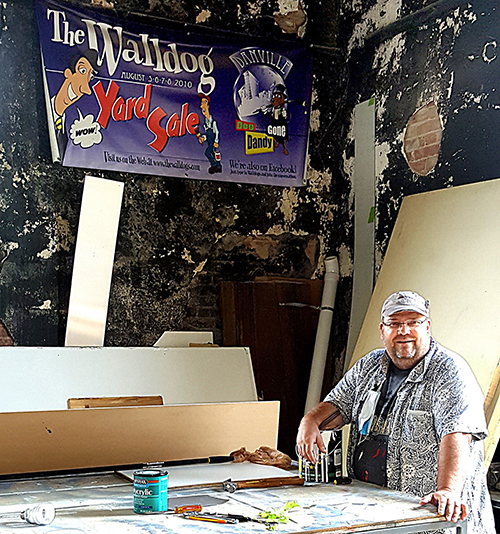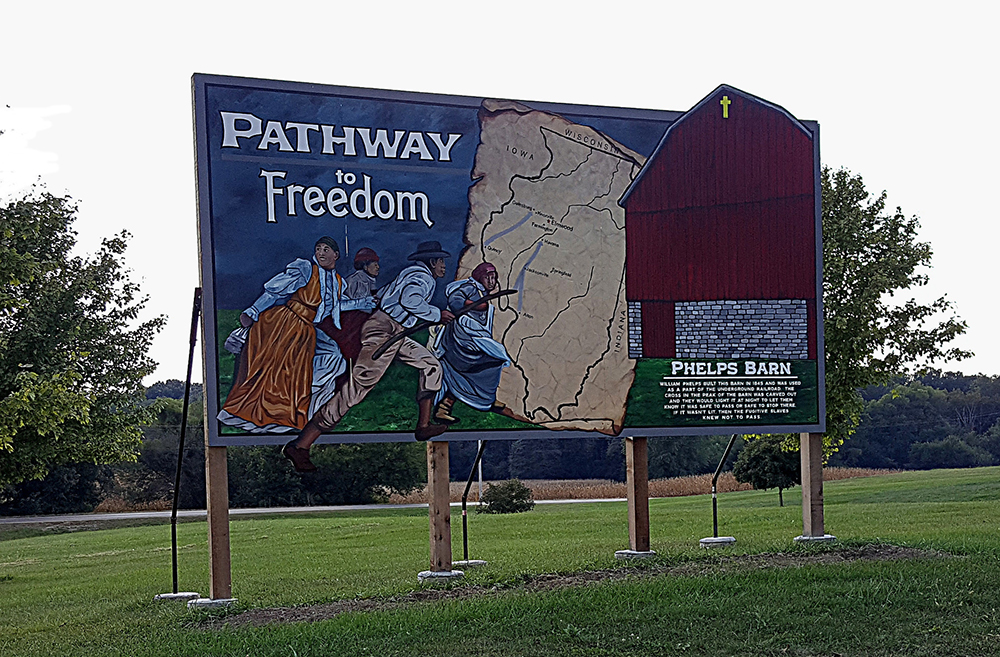
From his Mount Pulaski studio, Scott “Cornbread” Lindley works with townspeople and artists to create community murals throughout Illinois. (PHOTO BY BILL KNIGHT)
Scott Lindley’s life work has been about forging relationships and building community.
And painting.
Lindley, 52, heads up “Walldogs,” a group of artists who’ve created murals throughout Illinois, from a standalone piece chronicling Elmwood’s abolitionist past to a series of works in Kewanee, plus others in Aledo, Galva, Jacksonville, Pittsfield, Toulon and Wyoming, and 16 murals in Olney, alone..
Lindley supplies the imagery, but towns submit ideas, and dealing with communities is a positive, says Lindley, who likes a cooperative working relationship.
“I don’t want to ‘over-engineer’ a concept,” he says. “I rely on feedback – from the crew, from town leaders and passersby. We make adjustments as we go.
“There’s something great about painting in public”
He and Walldogs rekindle community pride, maybe with a bit of education or inspiration.
“The murals remind people of things that made an impact in their communities – that made them a community in the first place,” he says. “Older folks might have forgotten some of the stories, and younger ones maybe never knew. So the murals introduce the next generation to their shared history.”
Growing up in Marshall in eastern Illinois, the graphic artist known as “Cornbread” coordinates the loose group of artists and sign painters for assignments from his rustic CSL Studio in Mount Pulaski, Ill. Various artists with whom he’s collaborated are skilled people from Aledo and southern Illinois to Belgium.
Besides murals, Lindley’s usually colorful artwork is serious and playful, little and big. There’s a massive painting of an old-fashioned drive-in restaurant with a red ’57 Chevy in the foreground, and a wonderful “mashup” of Edward Hopper’s 1942 “Nighthawks” and Caravaggio’s 1525 classic “Supper at Emmaus,” with Jesus and a disciple added to the counter of the late-night urban diner.
Lindley says he refined his knack for person-to-person management in different ways, from running day camps for Cub Scouts to working in the building trades. He was in construction for eight years “starting as a carpenter’s helper, then carpenter, estimator and project manager,” he says.
“I was a foreman and a supervisor at a horrible job in a rural area outside Richmond, Va., working a job for a state building for dump trucks, dealing with heat, asbestos and the closest bathroom five miles away. It was nasty.
“The rest of the crew was all African American guys, and we started having Friday potlucks after work,” he continues. “It really built camaraderie, unity. I always brought chili and cornbread and one of the guys who always brought pork chops laughed and said his family joked that in their get-togethers his relatives started calling him ‘Uncle Pork Chop,’ and he started calling me ‘Cornbread’ and it stuck. Still does.
“Sharing those meals and that lousy work really brought us all together,” he adds. “We got through it.”
After injuring a leg in 2002, he returned to his passion, “finally for myself,” he says.
“I’m living up to what I went to college for,” says Lindley, who earned bachelor’s and master’s degrees at Eastern Illinois University. “I didn’t find that working for someone else.”
Lindley sees himself as an organizer, partner and side-by-side painter with his crew.
“I do whatever it takes,” he says. “We’re all part of a team; relationships are essential. We come across challenges and, together, we come up with solutions.
“I tend to mix colors on the fly.”
But his techniques are far from haphazard; detailed results show meticulous artistry and craftmanship.
“The key is good paint,” he says, “– 100% acrylic. It lasts.”
Although Lindley sometimes does “billboard”-type or creations mounted in other ways, he specializes in murals on structures.
“I prefer to paint right on buildings.”

Outside Elmwood, escaping slaves are shown in this standalone mural near a stop on the 19th century Underground Railroad, which had abolitionists helping people flee north. (PHOTO BY BILL KNIGHT)
In Elmwood, the local historical society helped underwrite murals of historically significant moments in the city’s past, with the first a mile south of town on Lilac Street/Wiley Road. There, a family of escaping slaves is depicted near Phelps Barn, a restored stop on the Underground Railroad built in the 1840s, when abolitionists would light lanterns and place them in a second-story window to signal the road north was clear of “slave catchers” hunting for runaway “fugitives.”
It’s the first of three planned this year, with three more in 2022 and plans for eight, all benefiting from area businesses and the Elmwood Development Association, pitching in for the Walldogs’ fee of about $10,000, “depending on size,” Lindley adds.
One mural due to be finished this month will feature Frank Wing, an Elmwood native who became a prominent author and nationally syndicated cartoonist based in Minneapolis, where he mentored Charles Schulz in the early days of the development of the “Peanuts” comic strip.
Lindley appreciates the possibilities of working with others and touching communities and neighborhoods, large and small. In fact, others’ similar endeavors are increasingly visible, if not yet exactly trendy. For example, the city of Peoria has a few, such as “The Faces of the East Bluff” on Wisconsin and Nebraska (assisted by LISC [Local Initiatives Support Corporation] and Adams Outdoor), and the “Western Avenue Mural” on 436 S. Western Ave. (also a LISC project, with help from the City and the Heritage Ensemble).
Lindley recognizes possibilities, he says.
“Sometimes it’s in the process, in the moment,” he says. “Then the stories just come out from the end of a paint brush.”

Recent Comments